The Missing Piece in Your Intent-Based Marketing Strategy
Running an intent-based marketing program can feel like a bit of a dice roll.
Gartner research shows that effective personalization can increase purchase likelihood by 12%. But it also shows that if you miss the mark, it can actually decrease it by up to 15%.
Not exactly great odds.
The key to winning? Relevance.
Sales and Marketing should align their touchpoints with where each buyer is in their journey.
This guide will detail how to use intent data to design genuinely relevant sales and marketing programs.
Meeting buyers where they’re at: The why behind intent-based marketing
Intent-based marketing is about aligning your marketing touchpoints with what buyers have shown interest in and where they are in the buying journey.
Consider two prospects. One has just requested a demo; the other just clicked an ad for a webinar you’re promoting.
They've each expressed different levels of intent, so they shouldn't see the same marketing messages going forward. They should see content that reflects where each one is in their journey.
In other words:
Intent-based marketing should reflect where each person, not an account, is in their specific buying journey.
Which, perhaps unsurprisingly, is exactly what buyers want. Sixty-two percent of your buyers expect you to adapt your marketing programs based on their actions and behavior.
A lot of marketing teams aren’t meeting that demand, which opens up an opportunity for marketers who can.
An intent-based marketing program that is aligned to the buying journey can help you cut through in saturated markets where reps are struggling to get face time.
The foundation of an intent-based marketing strategy
Intent-based marketing is most effective when you know exactly who you’re targeting.
Yes, you need a list of target accounts to go after, but in order to tap into contact-level intent (the stuff that really lets you craft relevant marketing programs), you also need to have the buying committee mapped out.
Here’s a short checklist to cross off before you start building an intent-based marketing strategy:
- Use historical data (LTV, churn rates, account growth) to define your ideal customer profile (ICP)
- Dive into tools like Crunchbase, LinkedIn Sales Navigator, or Apollo to build a list of accounts that match your ICP criteria
- Map out the buying group by identifying the people within each target account that match the roles and personas typically involved in the sales process (use your CRM data to guide you)
With that out of the way, you can start generating and using intent signals to fuel more relevant marketing programs.
Generating intent signals with contact-level ads
Instead of waiting for an intent signal to come to us from an external provider, we take a more proactive approach.
We run contact-level ad programs to capture engagement signals from prospects, understand their level of intent, and show them more of what they care about.
Early on in the buying journey, when the account is still in the pipeline generation stage, we don’t always have a lot of intel on what motivates prospects. Particularly if we haven’t spoken to them yet.
But what we do have is a pretty good idea of the kinds of things they’ll engage with, based on their persona.
So, we start with persona-based messaging, run an ad campaign, and use contact-level engagement data to refine from there.
We know from our research that the buying group usually includes these types of stakeholders:
- Senior marketers (e.g. CMO)
- Marketing managers (e.g. ABM manager)
- Marketing ops (e.g. Marketing Operations Manager)
We can show ads for each of the value propositions we know typically connect with each persona and monitor how they engage.
For example, we might show the ABM manager ads about reaching target buyers, while the Marketing Ops lead would see messaging focused on data security.
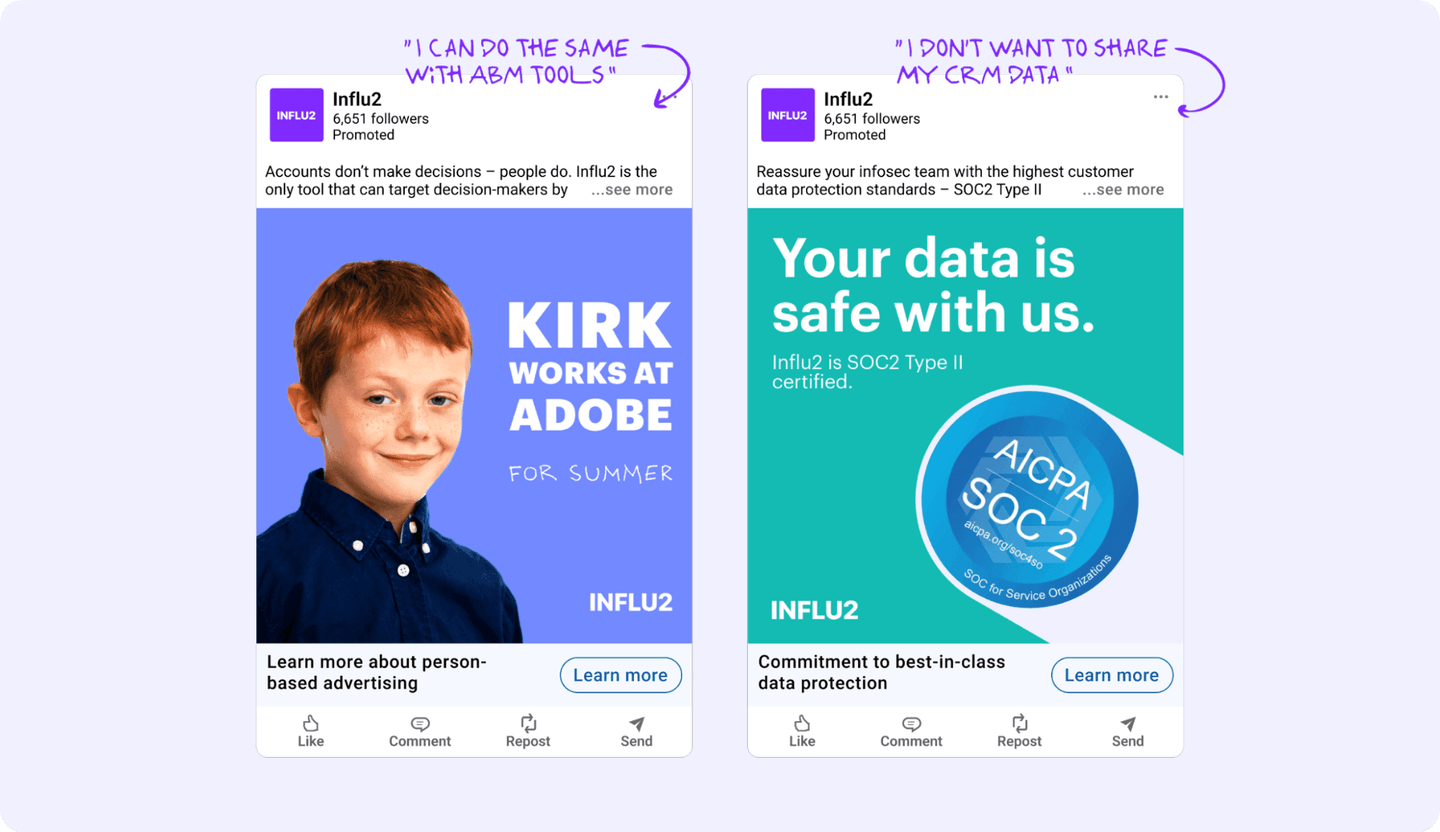
If the ABM Manager clicks on the ad about reaching decision-makers, they’ll see more of the same kind of message.
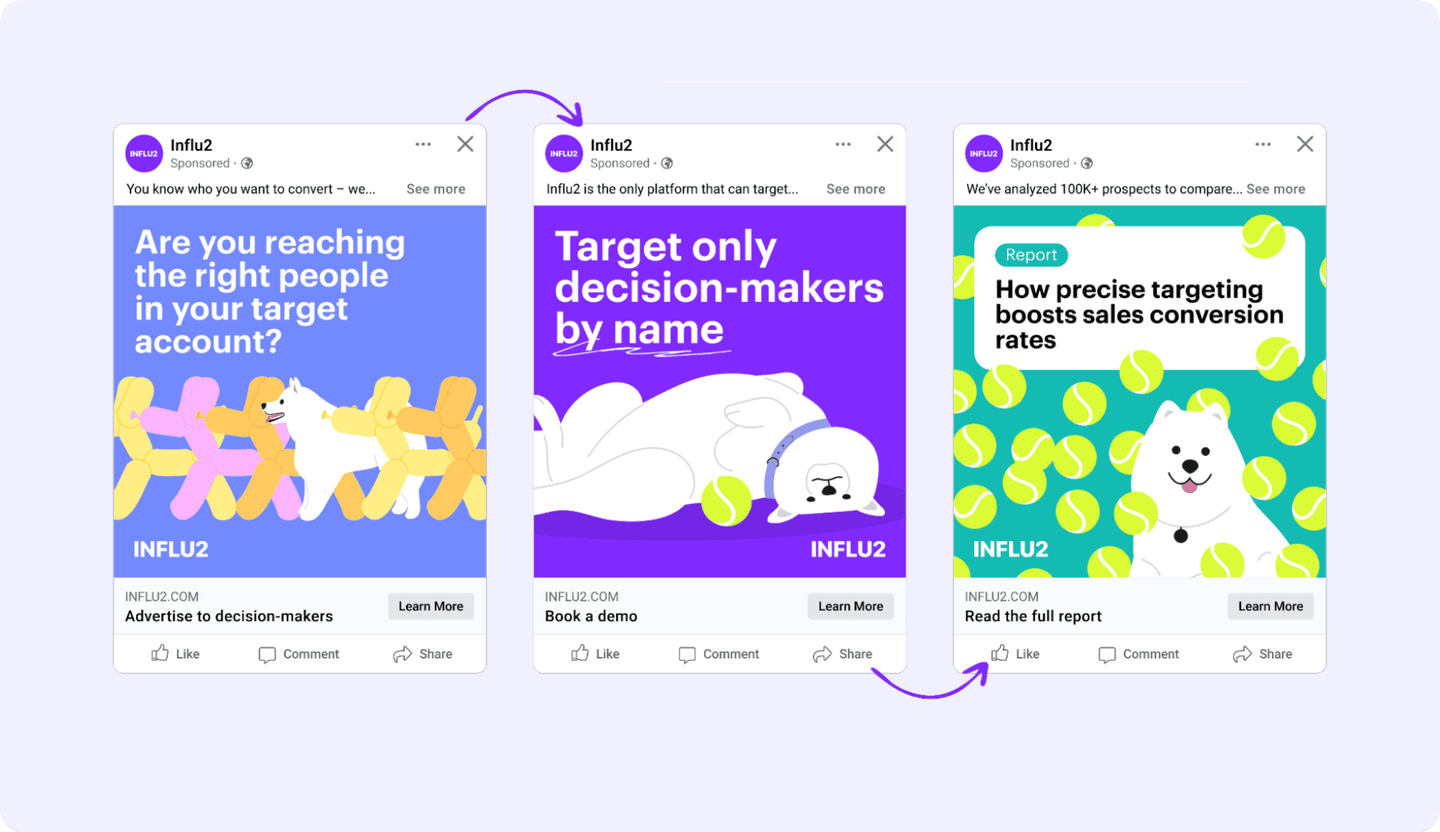
Supporting SDR outreach with ad air cover
As soon as the prospect clicks on one of those value props ads, the SDR on the account will get a Slack notification to begin their outreach sequence.
Rather than sending generic emails, our SDRs use the intent data we create to build a bridge between Marketing’s value prop ads and their outreach.
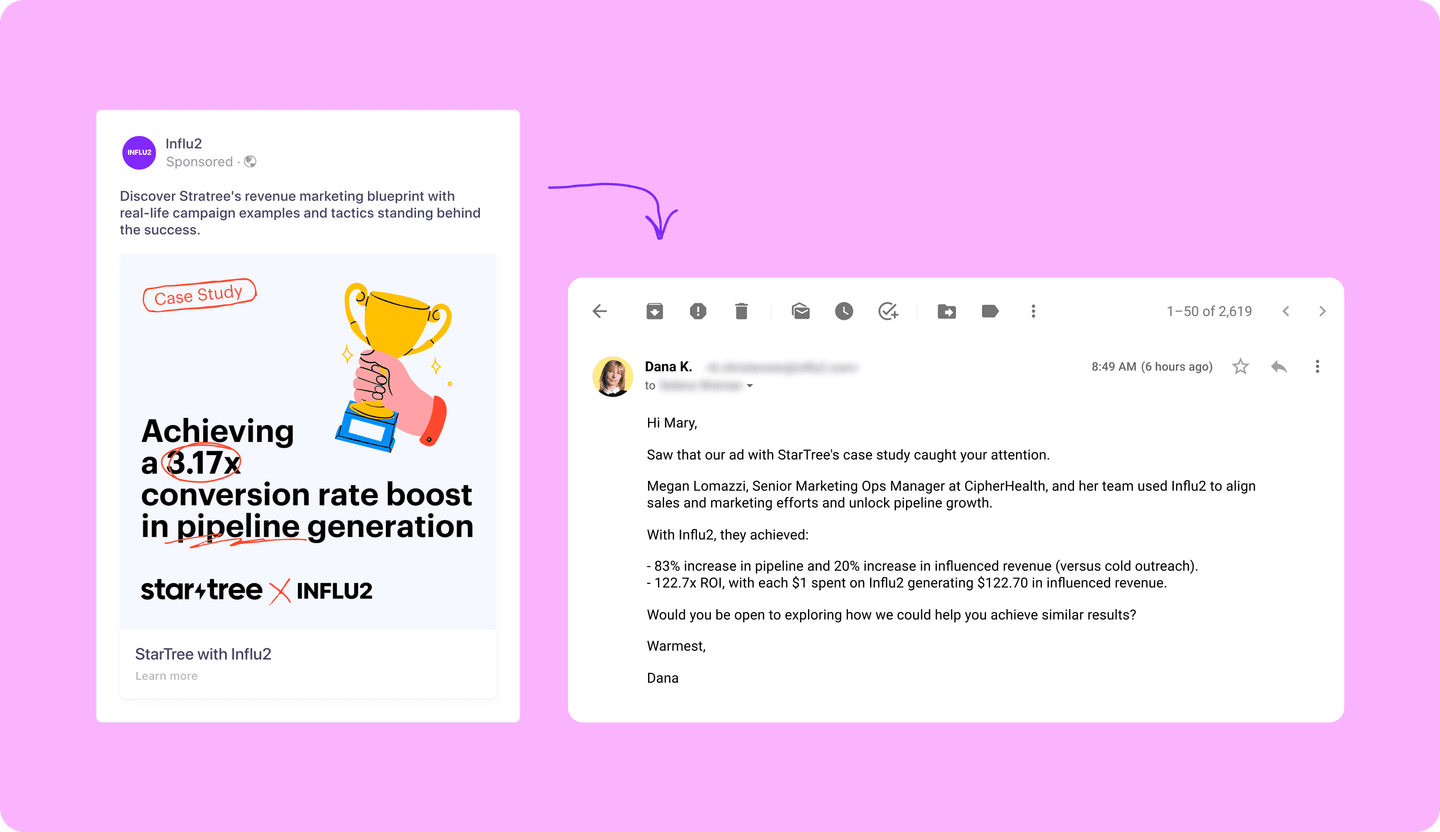
We also integrate this new intel on the prospect’s intent level into our marketing program.
Using data from our CRM, we know that the prospect has moved a step forward in the sales process (the SDR has initiated their outreach program).
We then provide ad air cover to help our SDR cut through by showing ads featuring them, alongside additional value prop and trust content relevant to the original ad they clicked on.
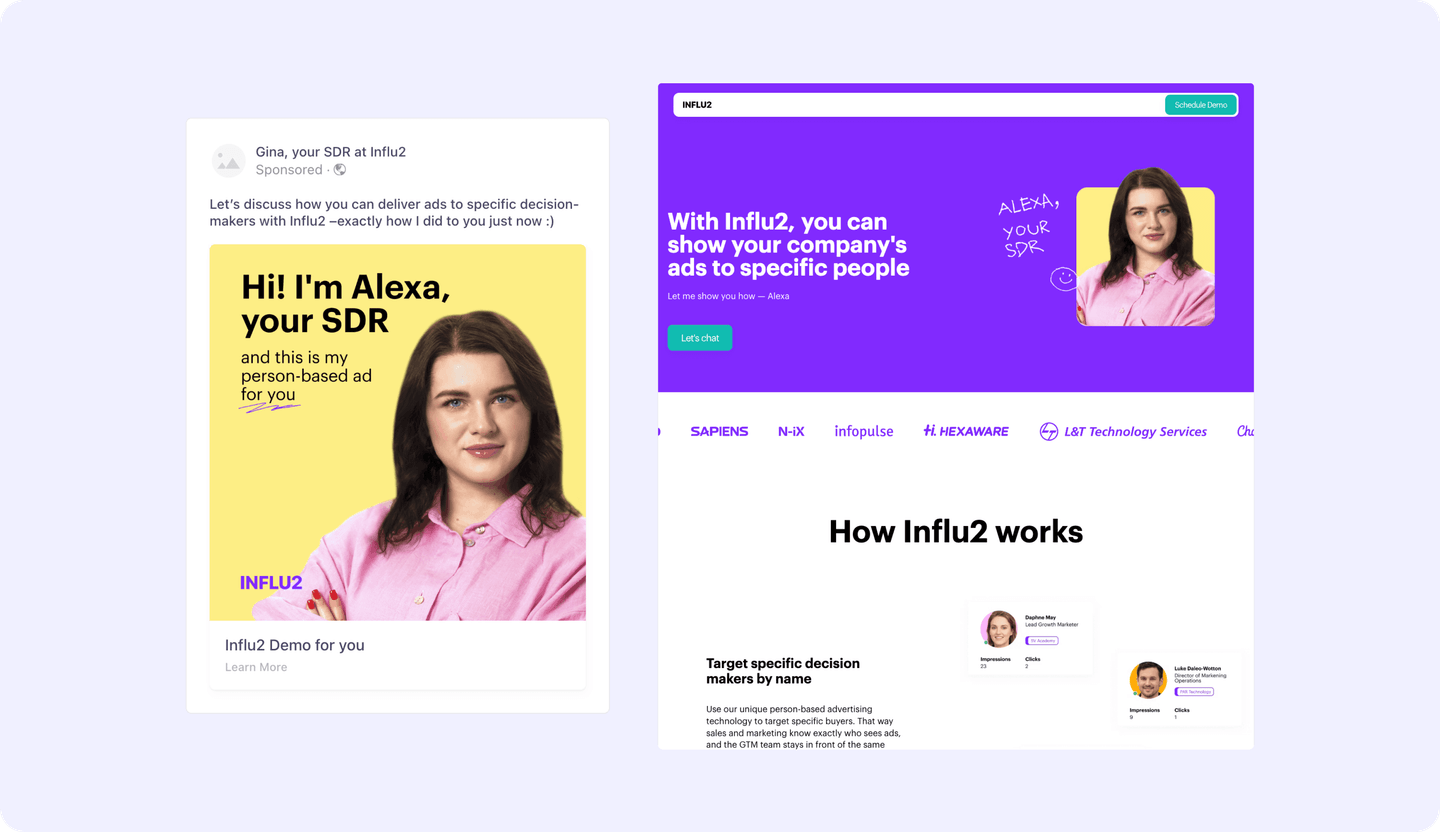
Increasing demo attendance rates
Once the SDR has connected with the buyer, the intent level changes significantly.
They’re no longer blind to our brand, product, and value props. They’ve agreed to a demo with an AE, meaning they’ve demonstrated intent to learn more about the product. Naturally, the marketing material they see should be under that context.
At Influ2, we run a three-pronged approach, all based on the intel we have on that prospect's intent.
1. Air cover for AEs
We help our AEs improve their demo show-up rate by tying the buyer’s intent to meeting reminders.
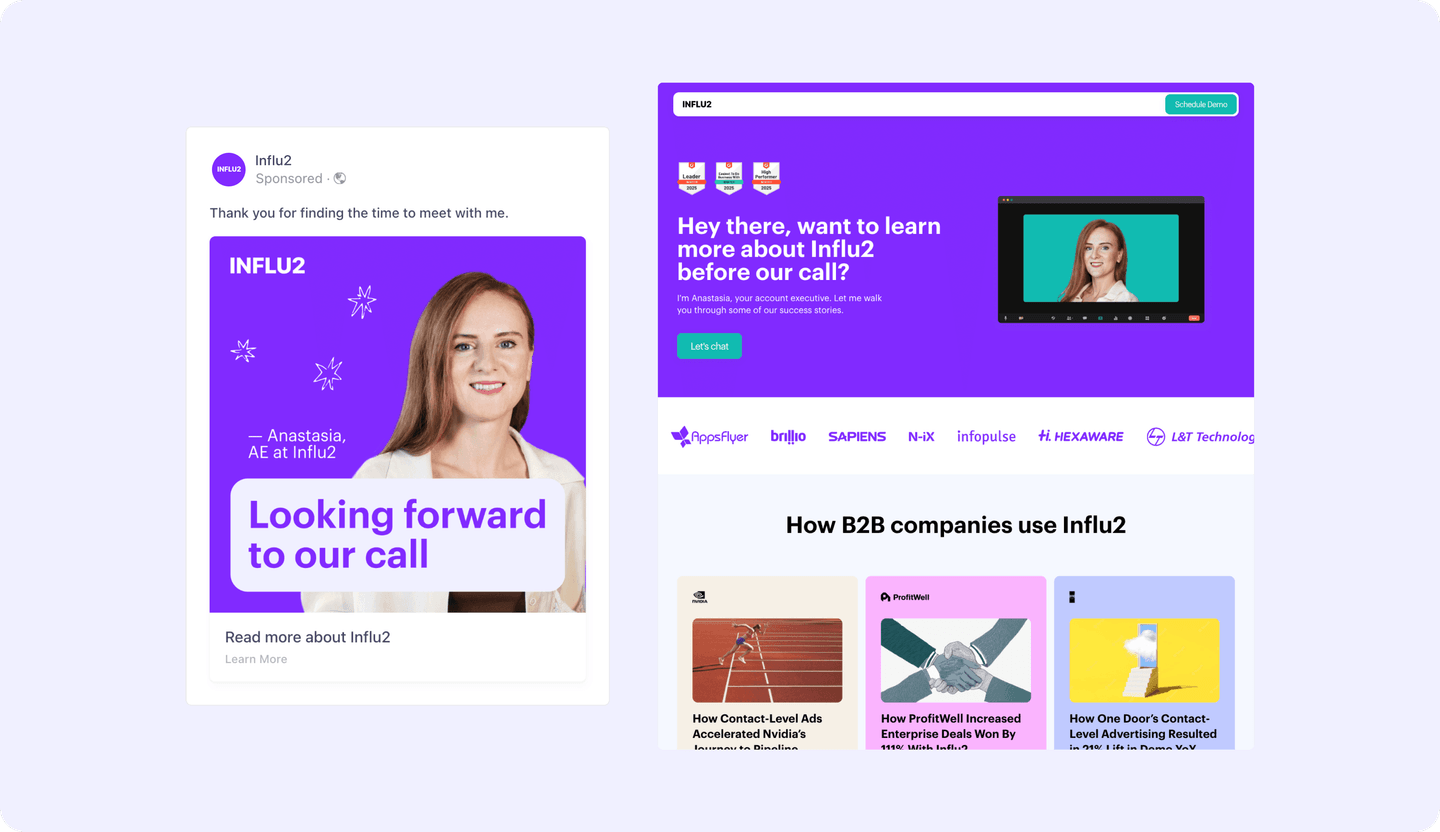
Putting a face to the name helps our AEs stand out, and subtly increases the prospect’s commitment to the meeting (it's a lot harder to leave someone hanging once you know they’re a real person).
It also gives us a chance to direct their attention to a bit more educational material, such as a value prop-focused landing page. Prospects that click through re-familiarize themselves with our brand and product prior to the meeting.
2. Practical educational content
The fact that the prospect has booked a demo signals something else: that they’re further along in their buying journey than before.
To align with that intent level, we switch from high-level thought leadership articles to deeper, more tactical educational content, such as guides, playbooks, and use case content.
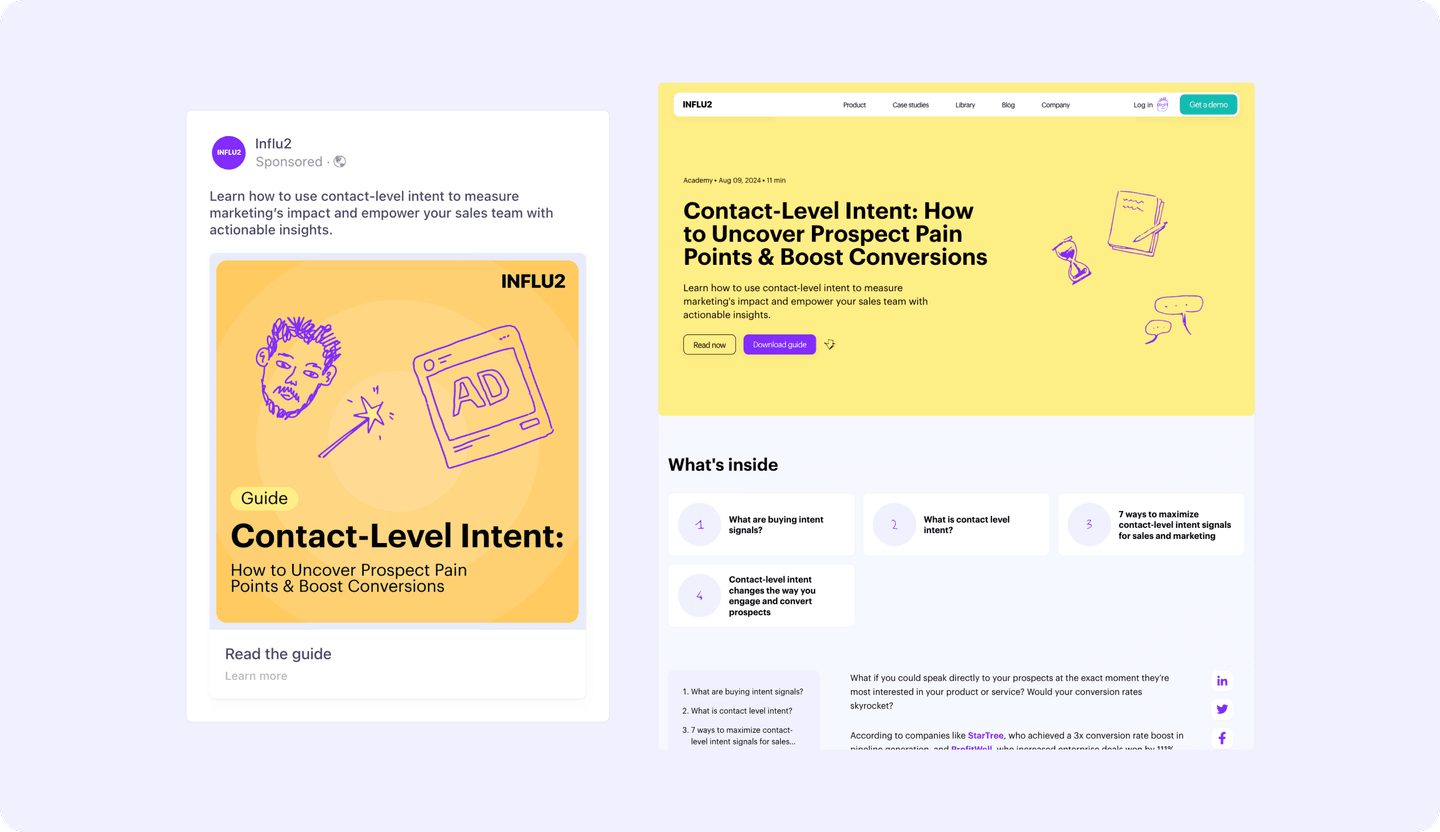
Ideally, the content we distribute is tailored to the other intent data we have on the prospect, such as content they’ve engaged with before or a pain point they shared during their conversation with the SDR.
3. Case studies to build trust
While the prospect has moved forward in their buying process, their interactions with our brand have been pretty limited so far.
We still need to build trust.
That’s a big part of what the AE will work on during and after the demo, but Marketing can support by promoting trust content like reviews and case studies.
Where possible, this should be aligned with buyer intent signals as well.
For example, our ABM Manager from the previous example would see a case study that touches on that exact pain point.
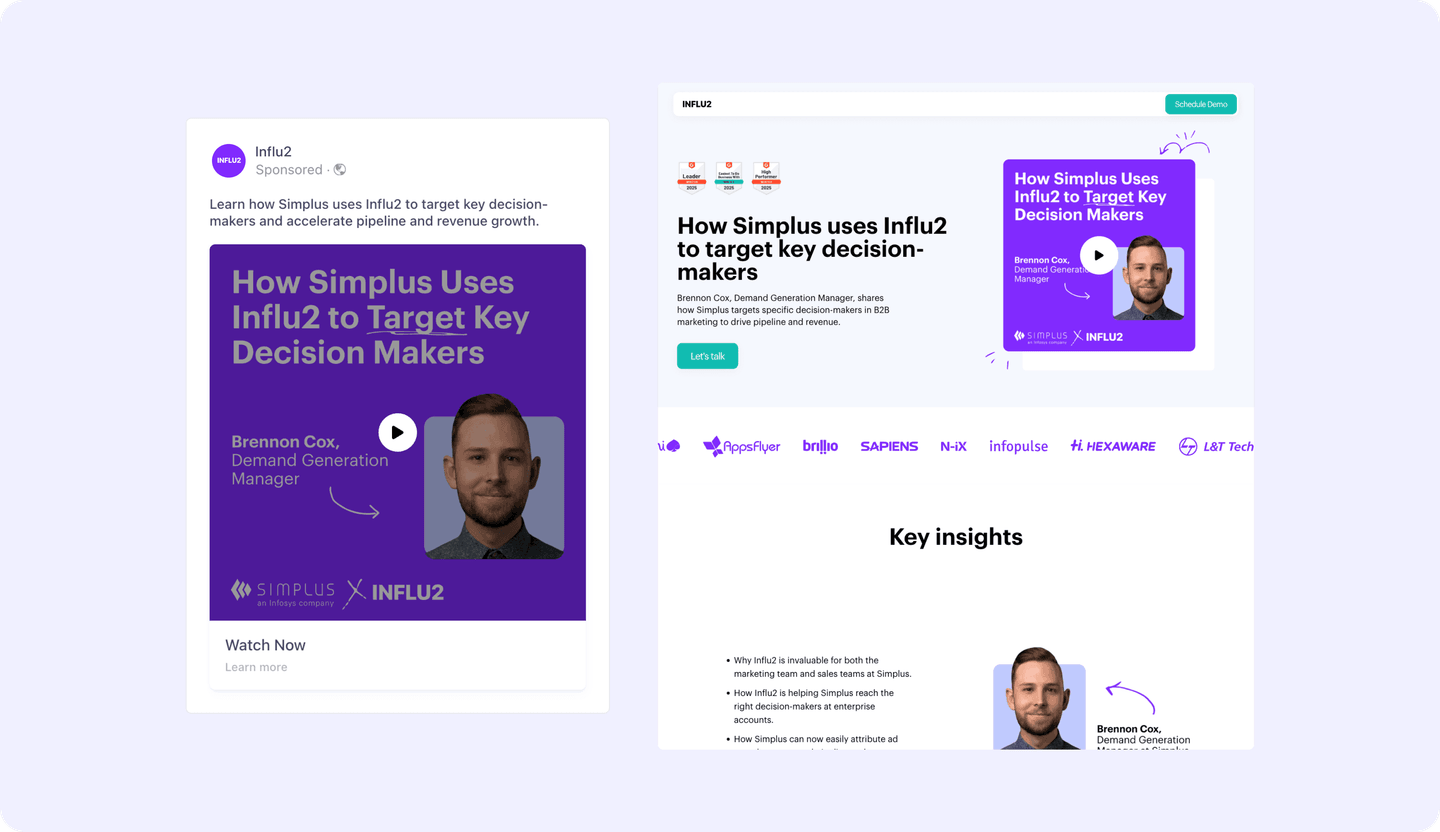
Driving pipeline progression post-demo
The next big step in the prospect’s buying journey is once they’ve had the demo with the AE.
Here, the intent changes again. They’re a step further in the sales process, but we also have more intel on their situation, challenges, and objections, all of which the AE uncovered during the call.
These are prime intent signals to use in supporting pipeline acceleration.
Let’s say our economic buyer in the deal is hesitant and has objections about price and return on investment.
We can show them ads that tackle that objection, like an ROI-focused case study.
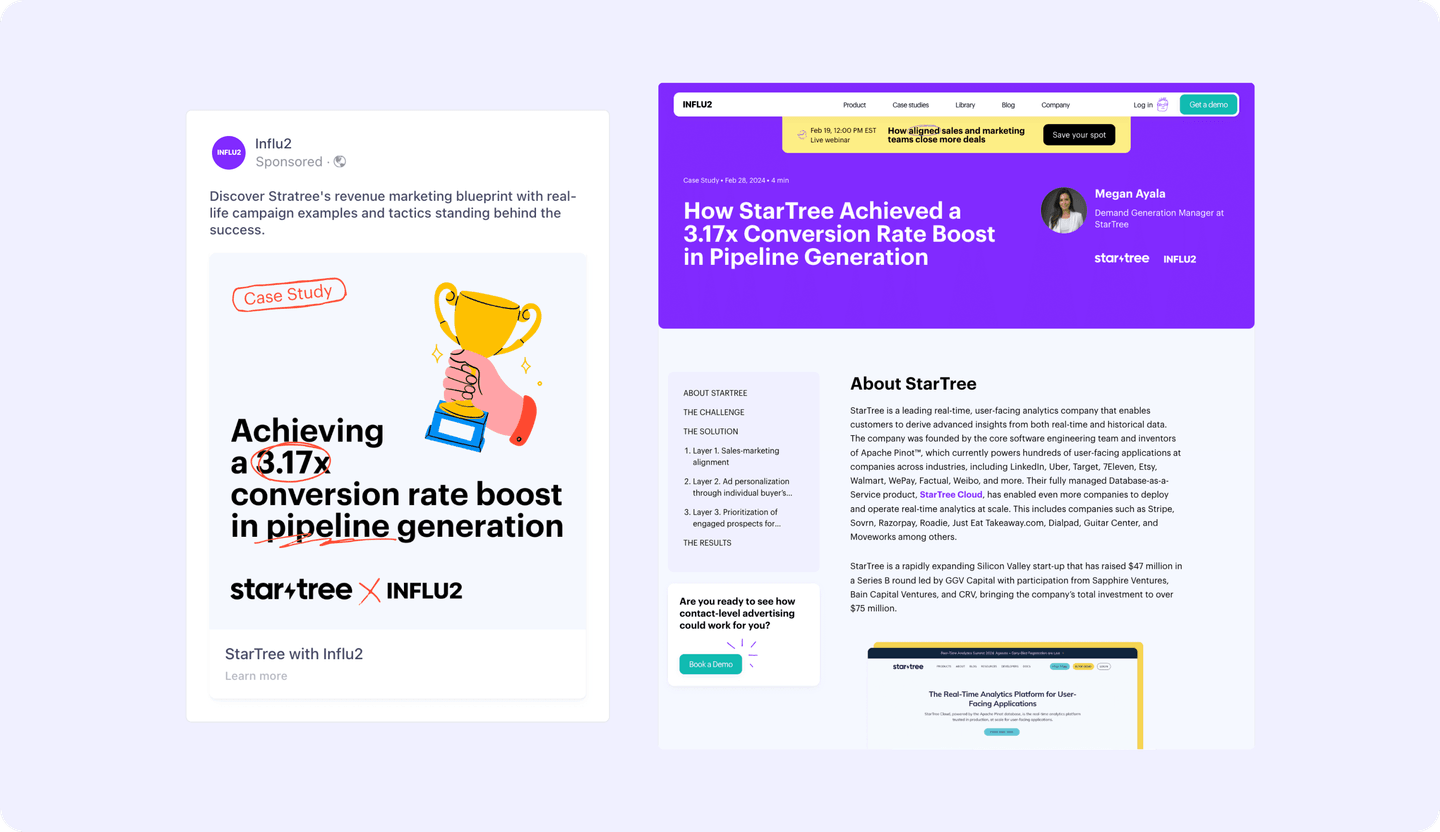
Bridge the gap between Sales and Marketing
The most effective intent-based marketing programs run alongside a sales process that reacts to the same intent signals. Sales share what they uncover with Marketing, and vice versa.
When marketing and sales speak the same language, the whole machine runs smoother. Better messaging gets the right leads in, sales closes them faster, and the pipeline grows. You waste less time on bad-fit prospects and focus on what matters.
Whenever a prospect clicks on one of your ads, Sales should be informed. SDRs can use this information to deliver more relevant email outreach:
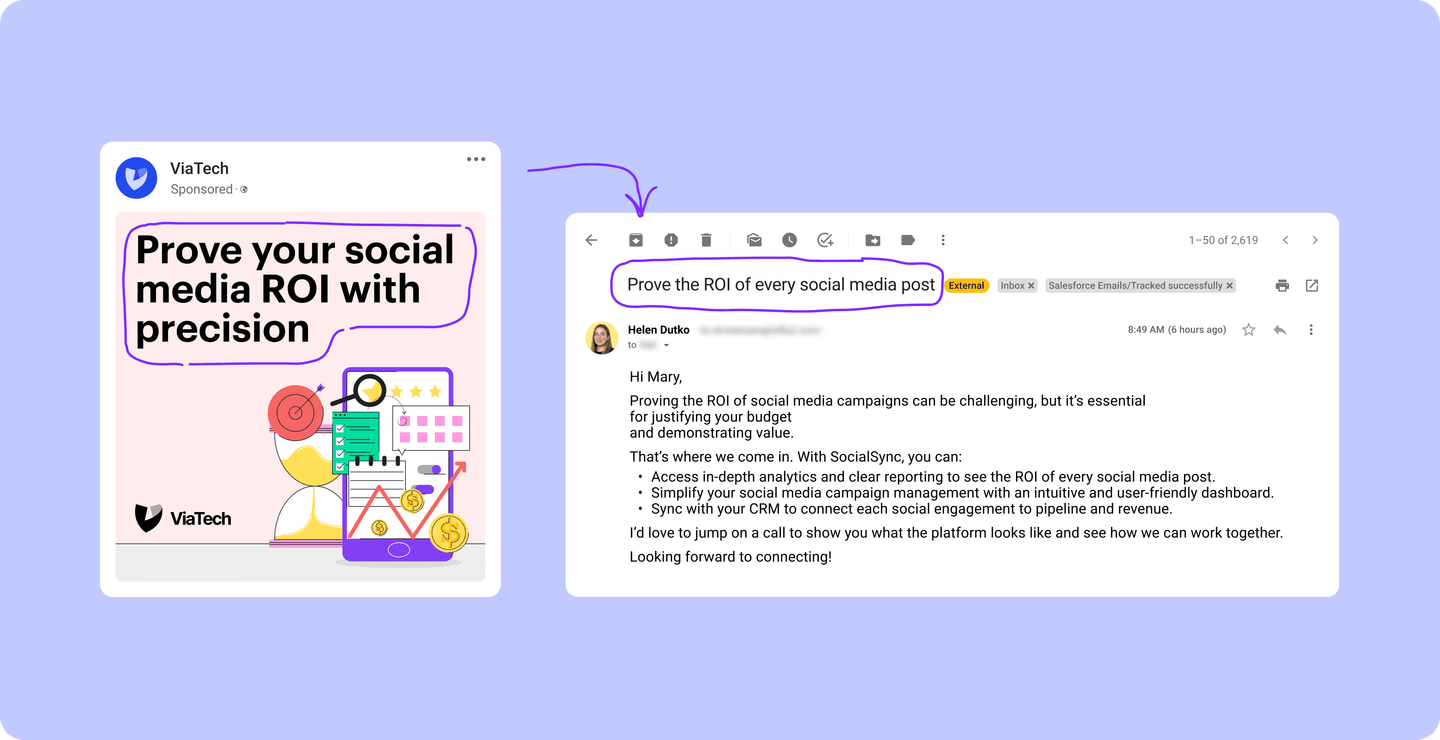
AEs can use ad engagement data to make their demos more relevant to that prospect’s intent, or to track how decision makers are engaging with objection-focused content after the sales call.
It shouldn’t be a one-way street, though. Intent signals from sales engagement tools should inform marketing programs as well.
Say the AE moves a prospect from an opportunity to closed/lost. The typical response here from Marketing is to put them in a generic nurture campaign.
But if you track the closed/lost reason in your CRM, there’s a useful intent signal there for marketing. Instead of throwing them into that generic nurture program, Marketing can place prospects in an email and ad journey specific to that reason.
Relevance is the missing piece to intent-based marketing
Your best shot at cutting through the noise won’t come from acting on a single buying signal like a job change alert or a negative review on G2.
That’s what everyone else is doing.
Instead, focus on delivering relevant sales and marketing touchpoints that align with the individual prospect’s stage in the buying journey.
Dominique Jackson is a Content Marketer Manager at Influ2. Over the past 10 years, he has worked with startups and enterprise B2B SaaS companies to boost pipeline and revenue through strategic content initiatives.


